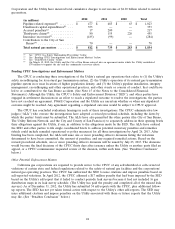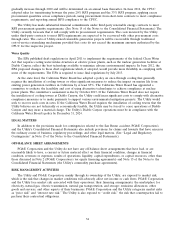PG&E 2012 Annual Report Download - page 38
Download and view the complete annual report
Please find page 38 of the 2012 PG&E annual report below. You can navigate through the pages in the report by either clicking on the pages listed below, or by using the keyword search tool below to find specific information within the annual report.gradually increase through 2020 and will be determined on an annual basis thereafter. In June 2012, the CPUC
adopted rules for transitioning between the prior 20% RPS program and the 33% RPS program, applying excess
procurement quantities across compliance periods, using procurement from short-term contracts to meet compliance
requirements, and reporting annual RPS compliance to the CPUC.
The Utility has made substantial financial commitments under third-party renewable energy contracts to meet
RPS procurement quantity requirements. (See Note 15 of the Notes to the Consolidated Financial Statements.) The
Utility currently forecasts that it will comply with its procurement requirements. The costs incurred by the Utility
under third-party contracts to meet RPS requirements are expected to be recovered with other procurement costs
through rates. The costs of Utility-owned renewable generation projects will be recoverable through traditional
cost-of-service ratemaking mechanisms provided that costs do not exceed the maximum amounts authorized by the
CPUC for the respective project.
Water Quality
The EPA published draft regulations in April 2011 to implement the requirements of the federal Clean Water
Act that requires cooling water intake structures at electric power plants, such as the nuclear generation facilities at
Diablo Canyon, reflect the best technology available to minimize adverse environmental impacts. In June 2012, the
EPA proposed changes to these draft regulations which, if adopted, would provide more flexibility in complying with
some of the requirements. The EPA is required to issue final regulations by July 2013.
At the state level, the California Water Board has adopted a policy on once-through cooling that generally
requires the installation of cooling towers or other significant measures to reduce the impact on marine life from
existing power generation facilities in California by at least 85%. The California Water Board has appointed a
committee to evaluate the feasibility and cost of using alternative technologies to achieve compliance at nuclear
power plants. The committee’s assessment is due by October 2013. If the California Water Board does not require
the installation of cooling towers at Diablo Canyon, the Utility could incur significant costs to comply with alternative
compliance measures or to make payments to support various environmental mitigation projects. The Utility would
seek to recover such costs in rates. If the California Water Board requires the installation of cooling towers that the
Utility believes are not technically or economically feasible, the Utility may be forced to cease operations at Diablo
Canyon and may incur a material charge. The Utility’s Diablo Canyon operations must be in compliance with the
California Water Board’s policy by December 31, 2024.
LEGAL MATTERS
In addition to the provisions made for contingencies related to the San Bruno accident, PG&E Corporation’s
and the Utility’s Consolidated Financial Statements also include provisions for claims and lawsuits that have arisen in
the ordinary course of business, regulatory proceedings, and other legal matters. (See ‘‘Legal and Regulatory
Contingencies’’ in Note 15 of the Notes to the Consolidated Financial Statements.)
OFF-BALANCE SHEET ARRANGEMENTS
PG&E Corporation and the Utility do not have any off-balance sheet arrangements that have had, or are
reasonably likely to have, a current or future material effect on their financial condition, changes in financial
condition, revenues or expenses, results of operations, liquidity, capital expenditures, or capital resources, other than
those discussed in Note 2 (PG&E Corporation’s tax equity financing agreements) and Note 15 of the Notes to the
Consolidated Financial Statements (the Utility’s commodity purchase agreements).
RISK MANAGEMENT ACTIVITIES
The Utility and PG&E Corporation, mainly through its ownership of the Utility, are exposed to market risk,
which is the risk that changes in market conditions will adversely affect net income or cash flows. PG&E Corporation
and the Utility face market risk associated with their operations; their financing arrangements; the marketplace for
electricity, natural gas, electric transmission, natural gas transportation, and storage; emissions allowances, other
goods and services; and other aspects of their businesses. PG&E Corporation and the Utility categorize market risks
as ‘‘price risk’’ and ‘‘interest rate risk.’’ The Utility is also exposed to ‘‘credit risk,’’ the risk that counterparties fail to
perform their contractual obligations.
34
























